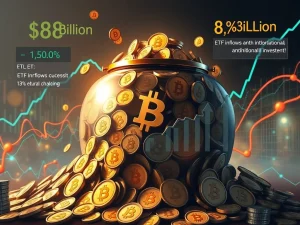Bitcoin Hodling: Proven Strategy Thrives in 2025 Market

For anyone navigating the unpredictable world of digital assets, understanding the core strategies is key. The **Bitcoin hodling** strategy stands out as arguably the most widely adopted approach, especially as we look at the landscape in 2025. It’s simple, effective, and has deep roots in crypto history. But what exactly does it mean to ‘hodl’ Bitcoin today, and why is this long-term perspective still relevant?
What is Bitcoin Hodling? The Origin Story
At its heart, **crypto holding**, or ‘hodling’, means buying cryptocurrency and keeping it for an extended period, ignoring short-term price swings. The term itself comes from a famous typo in a 2013 Bitcointalk forum post during a significant price crash. A user, frustrated but determined, declared ‘I AM HODLING’ instead of ‘holding’. This accidental phrase quickly became a rallying cry and a mindset within the community.
In a market often driven by quick trades and speculation, hodling offered a counter-narrative: conviction over timing. It’s about believing in the long-term value proposition of an asset like Bitcoin and refusing to sell during downturns. While born from a simple typo, it evolved into a fundamental **Bitcoin strategy**.
Did you know? The original ‘HODL’ post followed a 39% one-day Bitcoin price drop. The user admitted being ‘bad at trading’ but chose to hold, cementing the term’s legacy.
Why Does the Bitcoin Hodling Strategy Work?
The effectiveness of hodling is rooted in behavioral finance, particularly the concept of loss aversion. People tend to feel the pain of losses more intensely than the pleasure of equivalent gains. In volatile markets, this can lead to panic selling during price drops – often the opposite of what a long-term investor should do.
Hodlers counteract this by adopting a mindset often called ‘diamond hands’. This means committing to the **BTC long-term** vision, resisting the urge to sell based on fear or short-term market noise. It’s less about perfectly timing entries and exits and more about maintaining conviction when others falter.
This aligns with how Bitcoin is increasingly viewed in 2025: a store of value asset. Major financial firms now place Bitcoin alongside traditional assets like gold in their analyses. Data from CoinShares shows that over 70% of Bitcoin’s supply has remained unmoved for over a year, indicating strong conviction among long-term holders, including institutions and investment funds.
Did you know? By 2025, over 94% of Bitcoin’s total supply has been mined, highlighting its increasing scarcity as a long-term asset.
The 2025 Crypto Market: Context for Hodlers
Navigating the **2025 crypto** market requires understanding its unique factors. If you’ve been holding Bitcoin, you’ve seen significant events: market crashes, regulatory discussions, and institutional adoption. Yet, Bitcoin remains resilient.
Consider the journey: Bitcoin traded under $10,000 in 2020. By May 2025, it reached an all-time high near $112,000. This growth is heavily influenced by institutional interest. US spot Bitcoin ETFs, including BlackRock’s IBIT, have attracted billions in inflows, accumulating over $94 billion in assets under management collectively. This institutional embrace validates the **Bitcoin strategy** of long-term holding.
However, challenges persist in the **2025 crypto** environment:
- Regulation: While Bitcoin has avoided the harshest measures, the broader regulatory push continues. Discussions around capital controls on crypto in some regions add uncertainty.
- CBDCs: Central Bank Digital Currencies are rolling out globally. While not direct competitors to Bitcoin, they reflect governments’ increasing interest in digital monetary control.
- Yield Competition: The rise of tokenized US Treasurys offering competitive yields onchain presents alternative digital value opportunities beyond just Bitcoin.
- Energy Debate: ESG concerns related to Bitcoin mining remain a narrative challenge, despite increasing use of renewable energy sources by miners.
Despite these factors, many analysts and investors remain bullish on the **BTC long-term** outlook, with price models projecting significant future growth based on adoption and scarcity.
Tools for Long-Term Bitcoin Holding in 2025
Successfully executing a **crypto holding** strategy today is more sophisticated than in the past. There are tools designed specifically for the long-term holder:
- Secure Storage: Cold wallets (offline) like Ledger or Trezor remain preferred for maximum security. Hot wallets (online) have improved, offering features like multisig for enhanced protection.
- Institutional Custody: For high-net-worth individuals and institutions, qualified custodians like Fidelity Digital Assets provide secure, compliant vaulting services.
- Yield Generation: Newer platforms allow hodlers to potentially earn yield on their BTC. This includes staking derivatives on wrapped BTC, Bitcoin-native staking experiments, and earning yield via BTC-backed stablecoins or tokenized assets.
- Automation: Services like Swan Bitcoin enable automated recurring buys and withdrawals to cold storage, simplifying the dollar-cost averaging aspect of a **Bitcoin strategy**. Multisig providers also offer built-in inheritance and recovery features.
These tools make implementing a **BTC long-term** strategy safer and potentially more productive than ever before.
Summary: Why Hodling Endures in 2025
The **Bitcoin hodling** strategy, born from a simple typo, has proven its resilience and effectiveness, particularly in the **2025 crypto** market. It’s a mindset rooted in behavioral principles, focusing on long-term conviction over short-term trading. With increasing institutional adoption, a maturing asset class, and specialized tools for secure **crypto holding**, the case for a **BTC long-term** perspective remains strong. While challenges exist, the core idea of buying and holding Bitcoin continues to be a powerful and widely used approach for navigating the digital asset landscape.










